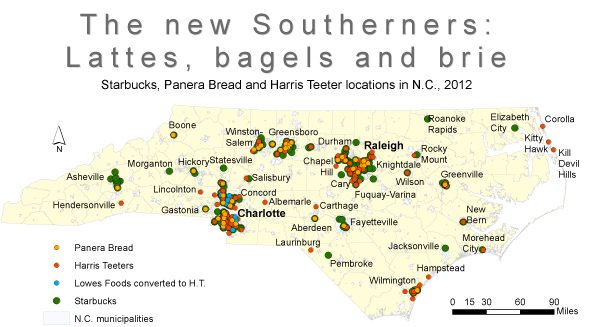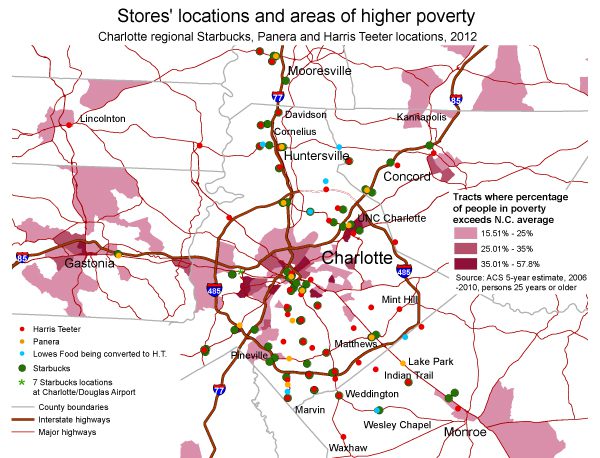Latte-free zones hint at demographic shifts
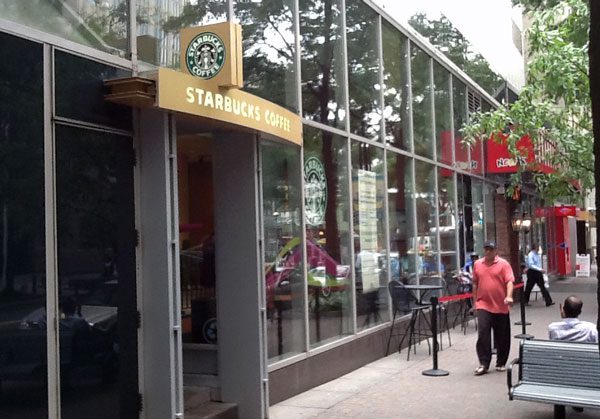
Along a 3-mile stretch of Rea Road in some of south Charlotte’s fanciest high-income neighborhoods, there’s no shortage of places to grab a latte or buy specialty cheeses and meat.
A Starbucks shop across from the entrance to a greenway features an outdoor patio with umbrella-covered tables. Only 1½ miles down the road two Starbucks coffeehouses, one in a Target store, and a Harris Teeter grocery store occupy prime spots in the upscale Stonecrest Shopping Center. Another 1½ miles further south, attracting plenty of customers in the similarly high-end Blakeney Shopping Center sit another Harris Teeter, a Starbucks sharing an outdoor sitting area with other restaurants, and a Starbucks tucked inside a Target.
In the upper-income Ballantyne community, only a few miles from Rea Road, Panera Bread joins Starbucks and Harris Teeter in competing for the loyalties and appetites of shoppers who can afford the upscale coffee, sandwiches and groceries.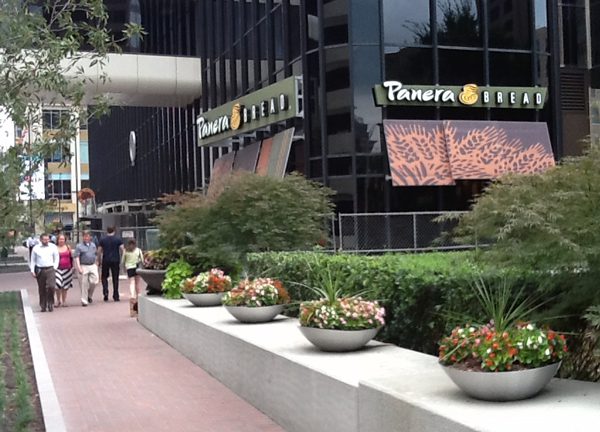
“If you shop at a Harris Teeter, dine at Panera Bread and get a cup of coffee at Starbucks, then you have some money in your wallet,” says Terry Shook, principal of the Shook Kelley design firm, which provides architecture, planning and brand strategy services to retailers across the country. “But it’s not just about wallets. These are all aspirational brands, brands that help complete people’s view of who they think they are.”
In assessing and choosing locations around the Charlotte region from Mooresville to Monroe and Hickory to Salisbury, and across North Carolina, these iconic stores have helped shape growth and development over the past decade, and just as important, they offer amenities that have noticeably contributed to neighborhood image and reputation.
Mapping locations of Starbucks, Panera and Harris Teeter isn’t just about those three popular companies, but is symbolic of the strategic decisions many companies make about where to locate. It’s a different lens through which to view disparities in income and perceived prestige for areas throughout the region and state.
|
“There are 33 counties in North Carolina where the death rate exceeds the birth rate. These stores are not going there.” – James H. Johnson Jr., UNC Chapel Hill |
“Everybody is jockeying to find a niche in the market,” says James H. Johnson, Jr., a professor at the UNC Chapel Hill Kenan-Flagler Business School and an expert on urban investment strategies. “There are 33 counties in North Carolina where the death rate exceeds the birth rate. These stores are not going there. There is going to be more concentrated affluence in our state and country. The patterns and locations of these stores is going to reflect that.”
The bottom line, says Johnson, is that Starbucks, Harris Teeter and Panera Bread are in business to make money. Their decisions today about where to locate exist at a time of a demographic shift that shows increasing separation along income and class lines. “Their locational strategies are consistent with the growing changes,” he says.
In North Carolina, Starbucks, Harris Teeter and Panera Bread cluster in shopping districts in the state’s largest, wealthiest urban areas – Raleigh/Durham, Greensboro/Winston-Salem/High Point and the Charlotte region. Those same businesses are absent from almost all of the state’s less wealthy and rural areas. The few exceptions tend to be in university towns (Elizabeth City, Pembroke, Boone), near major highways (Roanoke Rapids and Wilson along I-95) or near high-income pockets such as swanky Pinehurst (Carthage, Aberdeen).
In urban areas, they bypass low-income and transitioning communities. A virtual no-store zone arcs across Charlotte from the west side and through the northern part of the city – which has families with lower incomes, much of the city’s heavy industry and a large African-American community – to the moderate-income east side with its increasing immigrant population. The only Starbucks on the west side are at Charlotte/Douglas International Airport. In central and south Charlotte, where the three chains are concentrated along with other shopping options and a larger variety of restaurants, families have higher incomes.
Outside Charlotte, the stores are primarily in the northern and southern Mecklenburg towns. In neighboring counties, sites cluster to the northeast toward Concord and to the south and southeast, rather than west or east. If you drive east from Charlotte’s Elizabeth neighborhood, out Albemarle Road, you won’t hit a Starbucks until you reach the Pinehurst area.
Just west of Mecklenburg (median household income $52,363) in Gaston County (median household income $40,332), some residents were so eager for a Starbucks a few years ago that they created a Facebook campaign to bring one in their community. A Starbucks opened last October in a new Target in Gastonia.
“These stores are looking for a broad mix of people, but they generally market to people with the discretionary dollar,” says Frank Warren, a senior economist at Kimley-Horn and Associates, a national design consulting firm. “They’ll look at traffic patterns, not only where people live but how they go to work. They want a minimum number of households in their trade area.”
While snagging a Starbucks may highlight an area’s income, the lack of one can mean opportunities for local entrepreneurs, such Amélie’s French Bakery in Charlotte’s NoDa, or the Daily Grind in Stanly County’s Locust.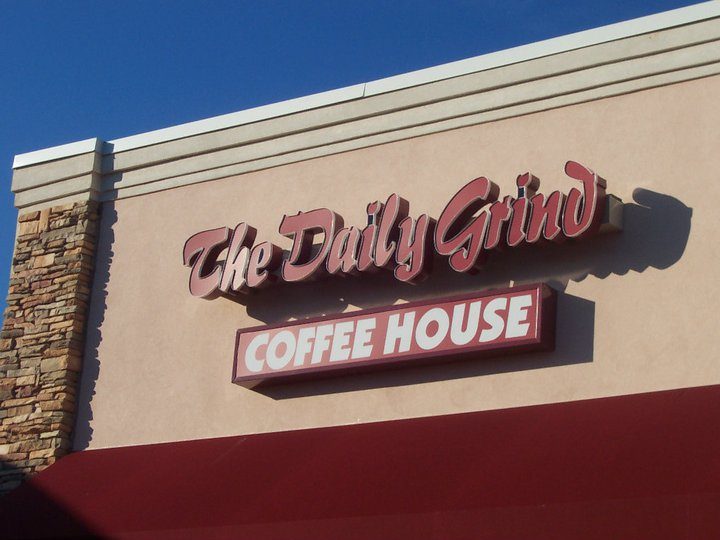
In a statement describing Harris Teeter’s target market, a spokesman says the company “actively seeks new real estate opportunities to conveniently serve its expanding customer base. We provide our shoppers clean stores, exceptional customer service and quality products at competitive prices that we feel appeal to the community.”
And Starbucks? “Choosing a site for a Starbucks location is a key element in providing customers with the Starbucks Experience,” the company says, in a statement. “Starbucks carefully considers many factors when opening a new store, and one of the most important is that members of the community have shown support for a Starbucks coffeehouse and the unique experience it provides.”
As part of its location strategy, the Charlotte-based Harris Teeter, the second largest grocer in the area, recently announced a store swap with Lowes Foods Stores. Harris Teeter bought 10 Lowes stores in Charlotte and nearby suburban areas, including Matthews, Mint Hill and Davidson. Lowes acquired six Harris Teeter stores in Gastonia, Hickory, Shelby and other areas in western North Carolina. “This transaction aligns with our strategic plans to replace rural store locations with more urban locations with higher density of our target demographic groups,” Thomas W. Dickson, Harris Teeter chairman of the board and chief executive officer, said in a company statement.
Starbucks, Harris Teeter, Panera Bread and similar stores not only target people with disposable income, says Shook of Shook Kelley Design, they market their brands to make emotional connections with customers and cater to their ideas about where they want to eat and shop.
“It’s all based on income, education and class and your views of where you are in the greater world,” says Shook. “They understand their customers. It’s cultural anthropology and psychology at the highest level.”
Correction (8/8/12): An earlier version of this article misspelled Kimley-Horn and Associates.
